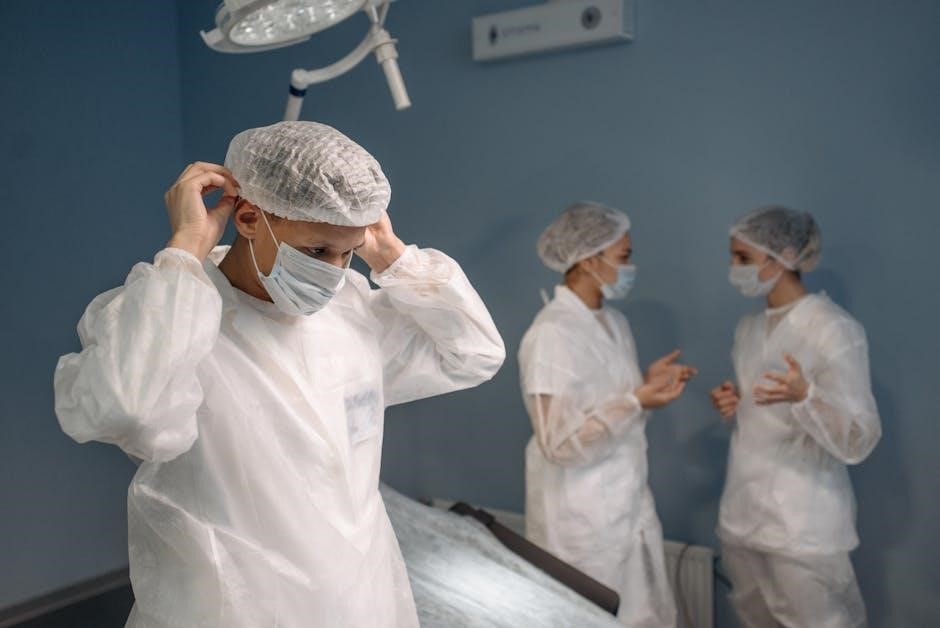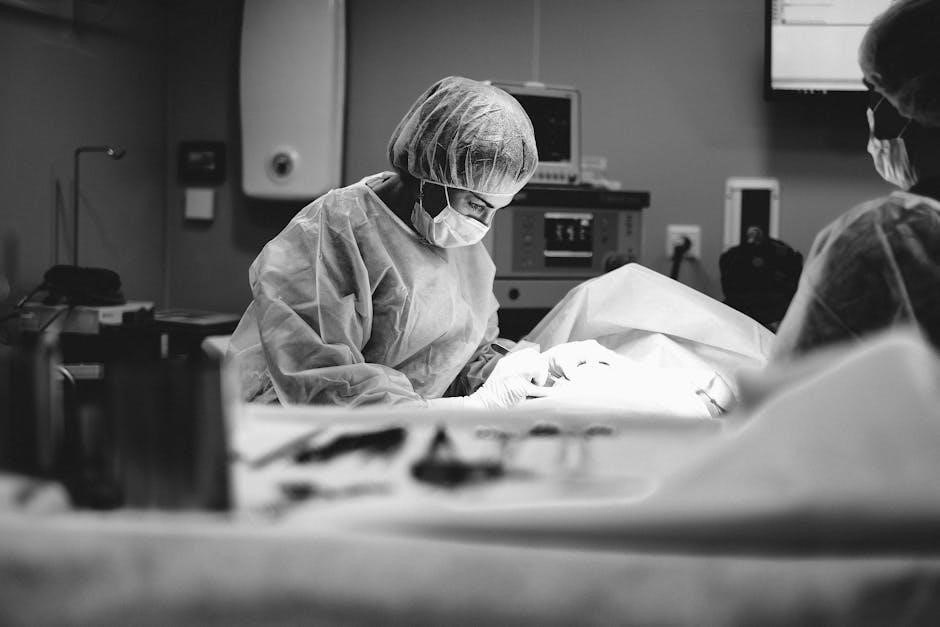A pocket guide to the operating room is a concise yet comprehensive resource designed for quick reference․ It covers essential procedures, safety protocols, and equipment, ensuring efficient preparation for surgery․ Surgical teams rely on it for practical, up-to-date information, making it an invaluable tool for busy professionals․
1․1 Overview of the Operating Room
The operating room (OR) is a specialized medical facility designed for surgical procedures, requiring precision and coordination․ It accommodates a multidisciplinary team, including surgeons, anesthesiologists, nurses, and surgical technologists, each contributing essential roles․ The OR houses advanced equipment and tools, such as anesthesia machines, sterilization systems, and monitors, to ensure patient safety and efficient operations․ Procedures can range from routine to complex, requiring meticulous preparation․
A pocket guide to the OR serves as a practical reference, outlining key steps, protocols, and safety measures․ It aids professionals in navigating pre-operation, intra-operation, and post-operation phases, emphasizing sterility and communication․ This guide ensures that all team members are well-prepared and informed, enhancing the overall surgical experience and outcomes․
1․2 Key Personnel in the Operating Room
In the operating room, several essential personnel collaborate to ensure successful surgeries․ Surgeons are responsible for performing the operations, utilizing their specialized skills and knowledge to address various medical conditions․ Anesthesiologists administer anesthesia, ensuring patients remain unconscious and pain-free during procedures while monitoring vital signs for safety․
Nurses provide critical support, assisting surgeons, managing instruments, and attending to patients throughout the process, maintaining sterility for infection prevention․ Surgical technologists prepare the operating room, sterilize tools, and ensure all equipment is ready for use․
Each role is integral to the surgical team’s functionality and effectiveness, contributing to optimal patient care and outcomes․

Key Personnel in the Operating Room

Key Personnel in theOperating Room

Surgeons
Perform surgical procedures, utilizing specialized skills to address medical conditions․
Anesthesiologists
Administer anesthesia and monitor patients’ vital signs during surgery․
Nurses
Provide support, assist surgeons, and manage instruments to ensure patient safety․
Surgical Technologists
Prepare the operating room and ensure all equipment is sterilized and ready for use․
Each role is essential in delivering efficient and safe surgical care․
2․1 Roles and Responsibilities of Surgeons
Surgeons are the central figures in the operating room, entrusted with performing surgical procedures and making critical decisions․
Their primary role includes meticulously planning and executing surgical approaches to address medical issues effectively․
Surgeons ensure patient safety by adhering to standardized protocols and best practices during operations․
Effective communication within the surgical team is crucial for maintaining a coordinated effort during procedures․
They are also responsible for managing unexpected complications that may arise, demonstrating quick thinking and expertise․
Surgeons can occupy different roles within the surgical team, such as being the primary operator, first assistant, or circulating surgeon, depending on their experience and the procedure’s complexity․
Their commitment to precision and patient well-being is vital, making them indispensable in the surgical setting․
2․2 Responsibilities of Anesthesiologists
Anesthesiologists are crucial for ensuring and comfort during surgery․
Their primary responsibility is to administer and manage anesthesia, ensuring patients remain unconscious and free from pain throughout the procedure․
They carefully monitor vital signs, including heart rate, blood pressure, and oxygen levels, to maintain stable conditions․
Anesthesiologists also adjust medications as needed to respond to any changes or complications during the operation․
Before surgery, they conduct thorough preoperative assessments to determine the best anesthesia approach based on the patient’s medical history and surgery type․
Additionally, they work closely with the surgical team to optimize patient outcomes and address any unexpected challenges․
Anesthesiologists play a vital role in post-operative care by managing pain and monitoring recovery․
2․3 Nurses in the Operating Room
Nurses in the operating room play a vital role in ensuring smooth surgical procedures․
They assist surgeons by preparing instruments and maintaining a sterile environment․
nurses also monitor patients’ conditions and communicate critical updates to the surgical team․
Their responsibilities include preoperative preparation, such as positioning patients and ensuring all equipment is ready․
During surgery, they may handle supplies, maintain records, and support the surgical team’s needs․
Post-operation, nurses help transport patients to recovery areas and monitor their initial recovery․
Their dedication to patient care and teamwork is essential for safe and efficient surgical outcomes․
2․4 Surgical Technologists
Surgical technologists are integral members of the surgical team, supporting surgeons and nurses during procedures․
They prepare surgical instruments, equipment, and supplies, ensuring everything is sterile and ready for use․
Their responsibilities include handing instruments to surgeons, controlling suction, and monitors during operations․
Surgical technologists also assist with patient positioning and draping to maintain a sterile field․
They work closely with the surgical team to ensure smooth operations and adapt quickly to unexpected challenges․
Their training and expertise in surgical techniques and equipment make them essential for maintaining safety and efficiency in the operating room․
Their role is crucial in ensuring that the surgical environment remains controlled and organized throughout the procedure․

Essential Equipment and Tools
Essential equipment in the operating room includes surgical instruments, anesthesia machines, monitors, and sterilization tools․ These tools ensure safety, efficiency, and precision during procedures, supporting surgical teams in providing optimal care․
3․1 Surgical Instruments and Their Uses

Surgical instruments are critical tools in the operating room, designed for precision and functionality․ A pocket guide typically categorizes them by purpose, such as cutting, gripping, or retracting tissues․ Common instruments like scalpels, forceps, and retractors are essential for various procedures․ Specialized tools, such as laparoscopic instruments, are used in minimally invasive surgeries․ Understanding their uses ensures efficient and safe operations․ The guide provides clear descriptions and illustrations, helping surgical teams choose the right tools for each case․ Proper handling and sterilization of instruments are also emphasized to maintain safety and prevent complications․ This section is vital for both experienced professionals and trainees seeking to master surgical techniques․
3․2 Anesthesia Machines and Monitoring Devices
Anesthesia machines are essential for delivering anesthetic gases, such as nitrous oxide and sevoflurane, to patients during surgery․ They ensure precise control of the concentration of anesthetic agents and oxygen, maintaining patient unconsciousness and pain relief․ These machines also incorporate advanced safety features, such as automatic oxygen fail-safe mechanisms, to prevent hypoxia․
Monitoring devices, including pulse oximeters, electrocardiography (ECG) machines, and end-tidal carbon dioxide (ETCO₂) monitors, are integral to assessing patients’ vital signs throughout surgery․ Pulse oximeters measure oxygen saturation in the blood, ECG monitors track heart activity, and ETCO₂ monitors evaluate respiratory function․ These devices provide real-time data, enabling surgical teams to quickly respond to any changes in the patient’s condition, ensuring safety and optimizing surgical outcomes․
For effective use, practitioners should be trained in operating and interpreting these devices․ Routine maintenance and calibration of anesthesia machines and monitoring devices are critical to ensure their reliability and accuracy․ Familiarity with these tools is vital for providing safe and efficient anesthesia care during surgical procedures․
3․3 Operating Room Monitors and Displays
Operating room monitors and displays are critical for providing real-time visualizations of vital data during surgery․ These devices include high-resolution screens that display patient monitors, imaging systems, and surgical cameras․ Surgeons rely on these tools to view detailed views of the surgical site, while anesthesiologists monitor patient vitals like heart rate and blood pressure․
Modern operating room displays often feature advanced functionalities, such as multitasking capabilities and customizable interfaces․ They integrate seamlessly with anesthesia machines, patient monitors, and imaging equipment, ensuring accurate and efficient data interpretation․ Regular maintenance and calibration of these devices are essential to guarantee optimal performance and reliability․
Familiarity with the latest monitoring technologies is vital for surgical teams to enhance patient safety and surgical precision․
3․4 Sterilization and Disinfection Equipment
Sterilization and disinfection equipment are essential for maintaining a safe and sterile environment in the operating room․ These tools ensure that surgical instruments, surfaces, and equipment are free from pathogens, reducing the risk of infections․
Automated sterilizers, such as autoclaves, use high-temperature steam to thoroughly sterilize reusable instruments․ Chemical disinfectants, including glutaraldehyde and hydrogen peroxide, are used for high-level disinfection of delicate equipment incompatible with heat․
UV light systems and surface further decontaminate the environment․ Handheld sprayers and wipes ensure quick, effective disinfection of high-touch areas․
Proper use of these devices is critical to maintaining aseptic conditions and protecting both patients and surgical team members․ Regular maintenance and calibration of sterilization equipment ensure their reliable performance, supporting infection control protocols in the operating room․

Common Surgical Procedures
Common surgical procedures include appendectomies, cholecystectomies, and knee replacements․ Minimally invasive techniques, such as laparoscopy, reduce recovery times․ Risk factors vary, but proper planning and aseptic techniques are crucial for success․ These procedures require precision and expertise to ensure optimal patient outcomes․
4․1 Elective and Emergency Surgeries
Elective and emergency surgeries are two distinct categories within the realm of operative care․ Elective surgeries are planned procedures, such as hernia repairs or knee replacements, where preparation time allows for thorough patient evaluation and risk assessment․ These surgeries often permit patients to mentally and physically prepare, reducing stress and optimizing outcomes․
In contrast, emergency surgeries are unpredictable and urgent, such as treating appendicitis or injuries from accidents․ These procedures demand rapid decision-making and immediate action to stabilize the patient․
Handling these surgeries in the operating room involves different approaches․ Elective surgeries enable detailed planning and scheduling, allowing the surgical team to coordinate resources effectively․ Emergency surgeries, however, require the OR team to act swiftly, often interrupting scheduled procedures to prioritize life-threatening cases․
The pocket guide serves as an invaluable resource in both scenarios․ For electives, it aids in planning and patient education․ For emergencies, it provides quick reference protocols to manage crises efficiently, emphasizing the importance of clear communication and adaptability․
4․2 Common Surgical Techniques
In the context of a “Pocket Guide to the Operating Room,” common surgical techniques are essential procedures that are frequently used across various surgical specialties․ These techniques ensure precision and efficiency, allowing surgical teams to perform operations with minimal complications․ Examples of common techniques include suturing, which involves closing wounds with surgical thread, and knotting, crucial for securing sutures․ Additionally, tissue handling techniques are vital to minimize damage during surgery․ Proper use of surgical instruments is another key aspect, ensuring accuracy and safety․ These techniques are foundational for both open and minimally invasive surgeries, though the latter often involves more advanced tools and methods․ Mastery of these techniques is essential for surgeons to perform effectively, making them a cornerstone of surgical education and practice․
4․3 Minimally Invasive Surgical Procedures
Minimally invasive surgical procedures are modern techniques designed to reduce trauma and recovery time for patients․ These methods, such as laparoscopy and robotic-assisted surgery, use small incisions and specialized instruments to perform operations with greater precision․ Advantages include reduced pain, shorter hospital stays, and faster recovery times․ Surgeons rely on advanced technologies like image guidance and robotic systems to enhance accuracy․ Benefits include lower complication rates and improved patient outcomes, making these procedures increasingly popular․ These techniques exemplify the evolution of surgical practices toward safer, more efficient alternatives․
4․4 High-Risk Surgical Procedures
High-risk surgical procedures require exceptional precision and preparedness due to their complexity and potential complications․ These surgeries often involve critical organs, advanced techniques, or patients with severe medical conditions․ Preoperative evaluations, thorough planning, and specialized equipment are essential for success․ Intraoperative monitoring and anesthesia adjustments are critical to manage risks in real time․ Postoperative care must be aggressive to address complications and ensure recovery․ Surgeons rely on advanced imaging, robotic-assisted technologies, and collaborative team efforts to enhance outcomes․ High-risk procedures demand rigorous attention to detail, proactive contingency planning, and constant vigilance to safeguard patient safety․ This section emphasizes the importance of expertise and resources in navigating these demanding surgical challenges․

Pre-Operation Considerations
Preoperative planning is critical to ensure a smooth surgical process․ Important steps include patient preparation, anesthesia pre-assessment, and team briefing․ Sterility and gowning procedures must be meticulously followed․ Thorough preparation minimizes risks and ensures readiness for surgery․ This pocket guide emphasizes the importance of these considerations, making it a valuable resource for surgical teams․
5․1 Patient Preparation Before Surgery
Patient preparation before surgery is a crucial step to ensure a safe and successful procedure․ This involves a thorough medical evaluation, obtaining informed consent, and preparing the patient physically and mentally․ Personal hygiene, such as bathing and removing jewelry, is emphasized to reduce the risk of infection․ Patients are instructed to fast and follow specific pre-operative guidelines․ Informed consent is documented in detail, ensuring the patient understands the procedure, risks, and benefits․ The pocket guide highlights these essential steps, providing clear, concise guidance for healthcare providers to follow․ Proper preparation minimizes complications and ensures the surgical team is well-prepared for the procedure ahead․
This pocket guide serves as a valuable resource, offering comprehensive instructions for patient preparation, including gowning and sterilization protocols․ It emphasizes the importance of attention to detail and adherence to safety standards to optimize outcomes and maintain a sterile environment․ By following these steps, surgical teams can ensure that patients are appropriately prepared for surgery, reducing risks and fostering a smooth surgical process․
5․2 Anesthesia Pre-Assessment
Anesthesia pre-assessment is crucial to ensure patient safety before surgery․ It involves evaluating the patient’s medical history, current health status, and potential risks associated with anesthesia․ This comprehensive process helps in choosing the most suitable anesthetic technique and minimizing complications․ The pocket guide provides quick reference tools for anesthesiologists to streamline this assessment, ensuring compliance with the latest safety protocols․ By incorporating state-of-the-art standards, the guide enhances the accuracy and efficiency of pre-assessment, ultimately improving patient outcomes and fostering trust between the surgical team and the patient․
5․3 Surgical Team Briefing and Planning
Surgical team briefing and planning are critical steps to ensure a smooth operation․ The pocket guide emphasizes the importance of preoperative meetings, where the surgical team reviews the procedure, potential risks, and roles․ Effective communication ensures that all members are aligned and prepared․ The guide highlights the need for thorough planning, including equipment checks, patient-specific considerations, and contingency strategies․ By fostering team collaboration and clarity, the pocket guide promotes patient safety and operational efficiency․ This phase of preparation is essential for minimizing errors and ensuring successful outcomes․ Proper planning and briefing ensure that every team member is informed, engaged, and ready to contribute effectively during the procedure․
5․4 Sterility and gowning Procedures

Sterility and gowning procedures are critical to ensuring a safe surgical environment․ The pocket guide emphasizes proper techniques for gowning and gloving to prevent contamination․ Before entering the operating room, team members must follow strict protocols, including hand hygiene, wearing protective gear, and scrubbing for the appropriate duration․ These steps minimize the risk of infection and maintain a sterile field․ The guide provides clear instructions for maintaining sterility during gowning, ensuring all personnel are prepared and compliant with standards․ Adherence to these procedures is essential for preventing complications and ensuring the success of surgical interventions․ Proper gowning also helps team members work efficiently and confidently in the OR environment․

In-Operation Protocols
6․1 Maintaining Sterility During Surgery
Maintaining sterility during surgery is critical to preventing infections․ Proper gowning and gloving protocols ensure aseptic conditions․ Surgical team members must adhere to hand hygiene and instrument handling guidelines․ Disposable items, such as drapes and equipment, must be used only once to eliminate contamination risks․ Regular monitoring and training help maintain high standards of sterility․ Compliance with these protocols helps create a safe environment for both patients and healthcare providers․
6․2 Intraoperative Monitoring and Anesthesia
Intraoperative monitoring and anesthesia are critical for ensuring patient safety during surgery․ Anesthesiologists use advanced devices to track vital signs, such as heart rate, blood pressure, oxygen levels, and brain activity․ These tools provide real-time data to adjust anesthesia levels and maintain stable conditions․ Anesthesia delivery techniques vary, including intravenous, Inhalational, or regional approaches, depending on the procedure and patient needs․ Proper monitoring ensures early detection of complications, enabling prompt intervention․ Effective anesthesia management, combined with precise monitoring, minimizes risks and supports optimal outcomes․ Team communication and adherence to protocols are essential for safe intraoperative care․
6․3 Communication and Team Coordination
Effective communication and team coordination are essential during surgery to ensure patient safety and successful outcomes․ The operating room team relies on clear and concise communication to maintain workflow, address concerns, and adapt to unexpected situations․ Roles and responsibilities are clearly defined, with the surgeon, anesthesiologist, nurses, and surgical technologists working in unison․ Regular updates on patient status, anesthesia levels, and procedure progress are shared to prevent errors and delays․ Handoffs between team members are carefully executed, ensuring all critical information is transmitted․ Open lines of communication and active listening minimize misunderstandings and enhance teamwork․ Strong coordination fosters a collaborative environment, reducing stress and improving surgical efficiency․ This seamless interaction is vital for maintaining sterility, monitoring equipment, and responding to emergencies․ Ultimately, effective communication ensures safe, efficient, and successful surgical care․
6․4 Emergency Protocols and Contingency Planning
Emergency protocols and contingency planning are critical components of operating room safety․ Teams must be prepared to respond swiftly to unforeseen complications, such as equipment failure, patient distress, or surgical crises․ Predefined emergency plans ensure that all staff know their roles and responsibilities during critical situations․ Regular drills and simulations help maintain readiness and identify potential gaps in preparedness․ Essential equipment, such as emergency drugs, defibrillators, and suction devices, must be readily accessible․ Effective communication and coordination among team members are vital during high-stakes scenarios․ Contingency planning involves anticipating risks and developing strategies to mitigate them, ensuring that the operating room remains capable of adapting to any situation․ Timely intervention and a controlled response to emergencies significantly enhance patient outcomes and safety․ By staying vigilant and prepared, surgical teams can navigate crises with confidence and precision․
Post-Operation Care
After surgery, monitoring recovery and vital signs is crucial․ Prompt detection and management of complications aid recovery․ Discharge planning and follow-up ensure continued patient well-being post-operation․
7․1 Immediate Post-Operative Care
Immediate post-operative care focuses on stabilizing the patient following surgery․ Vital signs, such as blood pressure and heart rate, are closely monitored to ensure the patient is не experiencing complications․ Pain management is prioritized, and medications are administered according to the care plan․ Nurses and surgical staff ensure proper positioning to prevent swelling or discomfort․ Effective communication among the team ensures seamless transition to rehabilitation or further care․ This phase sets the foundation for recovery, ensuring patient safety and well-being․
7․2 Pain Management and Rehabilitation
Pain management and rehabilitation are critical components of post-operative care․ Proper pain management ensures patient comfort while promoting healing and recovery․ Medications and techniques, such as analgesics, regional anesthesia, or nerve blocks, are tailored to the patient’s specific needs․ Rehabilitation focuses on restoring mobility, strength, and functionality, often through physical therapy or occupational therapy․ Nurses and rehabilitation specialists collaborate to provide a seamless transition from acute care to long-term recovery․ Effective communication between the care team and the patient ensures goals are met safely and efficiently․ This approach enhances recovery outcomes and improves the patient’s quality of life․
7․3 Monitoring for Complications
Post-operative care emphasizes the importance of continuous patient monitoring to detect potential complications․ These may include infections, hemorrhage, or adverse drug reactions․ Surgeons and nurses collaborate to implement effective monitoring protocols, ensuring timely interventions․ Regular assessments help in identifying early signs of complications, minimizing risks․ Communication among the surgical team is critical for coordinated care․ This vigilant approach ensures patient safety and promotes recovery․ Prompt response to any issues guarantees positive outcomes․
—
This section ensures that the focus remains on monitoring complications without repeating information from previous sections, adhering to the specified word count and formatting requirements․
7․4 Discharge Planning and Follow-Up
Discharge planning begins once a patient is stable, ensuring you’re prepared for home․ Coordination with healthcare providers is key, to address medications, wound care, and follow-up appointments․ Effective communication helps you understand your recovery needs, such as avoiding heavy lifting or seeking support if needed․
Follow-up care involves returning for check-ups to monitor healing and address any concerns promptly․ Your healthcare team will guide you through this phase, ensuring a smooth transition from hospital to home․ Understanding post-op care instructions is crucial for a successful recovery and preventing complications․
This structured approach supports continuity of care, ensuring you receive the necessary guidance and support throughout your recovery journey․
